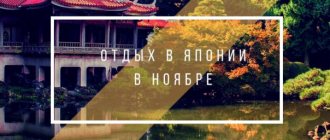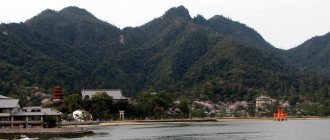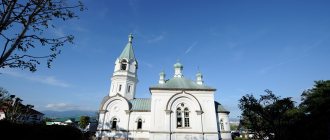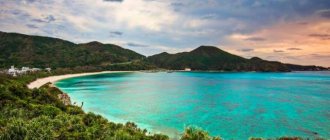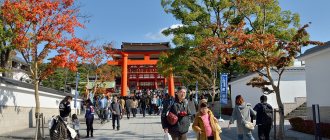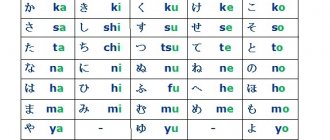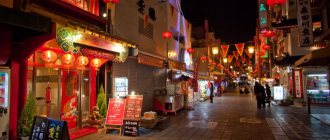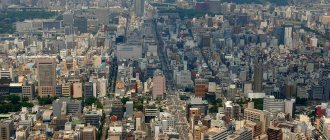Features of Ise Shrine
Ise Shrine in Japan, despite its forbidden nature, is popular among travelers. According to Shinto tradition, the shrine is destroyed every 20 years and then rebuilt. Therefore, there are differences in simplicity and modesty of scale. The appearance surprises with its simplicity.
The main shrine is dedicated to the sun goddess Amaterasu. The walls of the temple hide a large number of treasures of the country. They also contain relics of the imperial family. This structure houses the famous Sacred Mirror.
The temple is located in a beautiful area, in harmony with nature. Around there are hills covered with dense greenery and untouched forests. Tourists have the opportunity to walk through incredibly beautiful natural places. The park area is surrounded by a national park. It contains a large number of historical monuments and other shrines. Unlike Ise Shrine, they are accessible to visitors. In addition, on our website you can read useful information about the Inari Shrine.
A photo of the Uji Bridge, covered in the dim light of night lanterns, with horses rushing towards the shrine... This is one of dozens of photos depicting scenes at the Ise Shrine uploaded on the official Instagram page, while on Facebook there are photos of the Ise Shrine that more dedicated to its history and mysteries.
The number of Ise-jingu's posts on social networks began to grow rapidly. Many associate this with the upcoming G7 summit. Local authorities hope that the meeting of leaders of developed countries will attract more young people and foreign tourists to the region, and, of course, the number of visitors to the shrine will increase.
Attempts to popularize the temple using social networks began in December last year. Then photographs of the young priest of the temple were posted on the Internet. In November 2015, he created his own YouTube channel.
“Spreading information about the temple through visualization allows foreigners to better understand all its features. We also used Facebook, thanks to which people who never knew about it became aware of the temple,” said temple spokesman Shunitiro Nishimoto.
The executive director of the Ise Tourism Authority, Junichi Nishimura, spoke in his speech about how seeing is believing, so if you need to reach a non-Japanese audience, then Instagram photos are the best solution. He also added that such work will help not only increase the audience, but also actually increase the number of tourists.
Photos on the temple's Facebook and Instagram pages are updated twice a week, and videos are regularly uploaded to YouTube. As of March 7, the temple was visited by about 15 thousand people who learned about it through Facebook, and about 1000 from those who learned about the shrine on Instagram. The number of views of the video uploaded to the YouTube channel has already exceeded 28 thousand views.
Other shrines and temples in Japan, including Kiyomizu and Kifune Shrines, located in Kyoto, received between 100,000 and 130,000 visitors.
“More and more people who are not believers want to see various shrines. Therefore, the Internet becomes an effective means to reach a huge number of potential tourists,” said Masanari Itai, professor of sociology and religion at Kogakkan University.
Visitors to Ise-jingu enjoy free Wi-Fi in front of the Uji Bridge, as well as in Kaguraden and Sanshuden. In the future it is planned to increase the number of Wi-Fi points.
Nishimoto expressed his sincere hope that the world will learn much more about the temple and that by the summit the number of tourists will increase significantly. But Itai, a professor at Kogakkan University, said distributing photographs of the shrine could help popularize the Shinto religion around the world.
Based on materials from online publications.
Story
Now the temple is divided into two complexes - the inner sanctuary of Naiku, which was built in honor of the goddess Amaterasu, and the outer shrine of Geku, created in honor of the goddess of food Okunitama. In ancient times, they were located inside the imperial palace, and followed the emperor when he changed residence.
This tradition was broken in the 4th century by Emperor Sujin. He ordered the shrines to be moved to a village not far from his palace. Then his government was changed by Emperor Suinin, who ordered his princess to determine a permanent location for the shrines.
The story goes that the sun goddess herself contacted the princess in Ise and told her where it was necessary to build a temple. Then Amaterasu ordered the construction of a shrine to Toeuke for her cook. Over time, buildings for horses and roosters of the goddess were created in the temple complex. Near the sanctuary there is a vegetable garden where vegetables are grown. They are used to prepare food for the deity.
The fascinating history and mystery of the temple attracts tourists to look at the sanctuary even from afar. The journey promises to be interesting and exciting. Harmony with nature promotes mental relaxation.
Interesting information
- According to legend, the temple was founded about 2000 years ago by Yamatohime no Mikoto at the behest of the goddess Amaterasu herself. However, the forests around the temple were also considered sacred. They remain so today.
- From the 7th to the 14th centuries, the role of the high priestess of the temple was performed by girls from the imperial family. Now the tradition has been restored, the priests and priestesses come from among the relatives of the emperor or their descendants.
- On the temple grounds you can find roosters, which are revered as Amaterasu birds.
Annual festivals
Otaue ceremony.
From the late seventh century, when festivals and offerings at Ise Shrine became more formalized, a number of annual events were held at both Naiku and Geku. Tsukinamisai, which was held in June and December, and the Gangnamsai Festival in September were the only three offerings made by Sayu, the imperial princess who served as the shrine's high priestess until the 14th century. These suggestions are based on the cycle of the agricultural year and are still carried out today.
The first important ceremony of the modern calendar year is Kinensai, when prayers are offered for a bountiful harvest. Gangnamesai, where prayers are made for good weather and sufficient rainfall, is held twice a year in May and August in Naiku and Geku.
Kagura Autumn Festival.
The most important annual festival held at Ise Shrine is the Gangnamsai Festival (神嘗祭). This ritual, performed annually in October, makes an offering to Amaterasu of the first harvest of that season's harvest. The Imperial envoy brings Ise an offering of rice harvested by the Emperor himself, as well as five-color silk cloth and other materials called heihaku.
In addition to the agricultural ceremonies already mentioned, Naiku and Geku host ceremonies and festivals throughout the year to celebrate the New Year, the founding of Japan, past emperors, purification rituals for priests and court musicians, the fermentation of good sake, and the emperor's birthday. Also, offerings are made to the kami temple every morning and evening.
Ise Jingu
In the small Japanese city of Ise there is an ancient temple, which is one of the main shrines of Japan. For a long time it was believed that all the rituals that were carried out on its territory directly influenced the fate of the imperial family and the entire country.
History of Ise Jingu
According to Japanese legends, the shrine was built for the deity Amaterasu o-mikami and her assistant Toeuke. At first it was located right in the emperor’s chambers. Several centuries later, Emperor Suinin commissioned Princess Yamato-hime no Mikoto to find a more suitable location for the shrine. Since then, it is the princesses who are the priestesses of the main Shinto shrine in Ise.
From the very beginning, it was decided that this temple would be maintained at the expense of the state, because its activities directly influenced the life of the country. But when the shoguns came to power, funding for the Ise Jingu Shrine ceased. Until the 17th century, it consisted only of rare donations. This led to dilapidation and partial destruction of the temple complex. At the end of the 15th and beginning of the 16th centuries, restoration work began, during which the Ise Jingu Temple was reconstructed almost from scratch.
Structure of Ise Jingu
This Shinto shrine is located inside a national park, behind a high wooden fence. It is divided into two complexes:
- Naiku is an inner sanctuary dedicated to the goddess Amaterasu;
- Geku is an outer sanctuary dedicated to the goddess’s assistant, the cook Toeuke.
Both parts of Ise Jingu Temple are 4 km apart from each other. Until 1945, the Miyagawa River flowed between them and the rest of the world, which served as a sacred border. At that time, as now, access to the main Shinto shrine in Ise was limited to high-ranking clerics and members of the imperial family.
In addition to the main and secondary sanctuaries, the following subsidiary farms are located here:
- gardens and vegetable gardens;
- salt mill;
- stables for the deity's horse (shinme);
- chicken coop for sacred roosters (shinkei);
- premises where sake production takes place.
It is believed that the grounds of the Ise Shrine in Japan are inhabited by spiritual beings, kami. For them, special dishes are prepared over a clean fire and served on simple clay plates and cups.
A pilgrimage trail leads from the outer sanctuary to Nike. Along it there are souvenir shops and small shops where tourists and pilgrims can buy the necessary food. The pilgrimage road leads to a bridge located over the Isuzu River, and from it to the inner temple of Ise Jingu. Previously, before visiting the shrine, you had to take a bath in the Isuzu River, but now it is enough to simply wash your hands and mouth. There is a Temizuya pavilion for this purpose. If necessary, anyone can go down to the river and perform a full ablution ceremony.
It is believed that the spiritual deities of the kami love purity and novelty, so every 20 years new shrines are built in Ise Jingu. The last reconstruction was carried out in 1993, and the next one will be in 2023. Despite the fact that hundreds of thousands of volunteers are involved in the construction, it costs several tens of millions of dollars.
Activities of Ise Jingu
After a long isolation of the temple complex, during which it was excluded from government funding, its active propaganda began. This was done by venerable mentors (onshi), who visited the provinces and encouraged the local population to make a pilgrimage to the main Shinto shrine of Japan in Ise. The fact is that before this, campaigning was prohibited, but with the advent of peace, the number of pilgrims increased sharply.
Thanks to the activities of the onshi, who distributed pieces of cloth and paper with the name Amaterasu among the local population, by the 19th century, 90% of families already had jingu amulets.
Special attention
- When visiting the Ise Shrine, you need to follow a certain order: first Geku then Nike. The most convenient way to get to Geku is from Iseshi Station (Kintetsu Railway and JR lines). From the station - just 5 minutes on foot. You can either walk to the next temple (50 minutes) or take a direct express bus in 10 minutes.
- Ise hosts many festivals, but the most prominent event is the regular renovation of the temple. It is held every 20 years, and the location of construction changes. Interestingly, this tradition has been around for many centuries. The next one, the 63rd, is planned for 2033.
Content
- 1 Foundation of the shrine
- 2 High Priestess/Chief Priest
- 3 Temple architecture
- 4 Restoration of the shrine
- 5 annual festivals
- 6 Naikū - Inner Shrine 6.1 Uji Bridge
- 6.2 Temizusha
- 6.3 Saikan and Anzaisho
- 6.4 Kaguraden
- 6.5 Imibiyaden
- 6.6 Kotai Jingu - the main shrine
- 8.1 Shrines
external links
| Wikimedia Commons has media related to: Ise Shrine (category) |
| Wikivoyage has a travel guide for Ise . |
- Official website
- Ise Jingu - General overview of Iseshima attractions
- Ise City Tourism Industry Society
- New York Public Library Digital Gallery, early photograph of the Ise Shrine complex
- Photographs of Ise Shrine by Yoshio Watanabe, Canadian Center for Architecture
- Smithsonian Magazine is a Japanese Shrine
- Accessibility of the shrine for disabled people
- Geographic data related to Ise Naiku Shrine on OpenStreetMap
